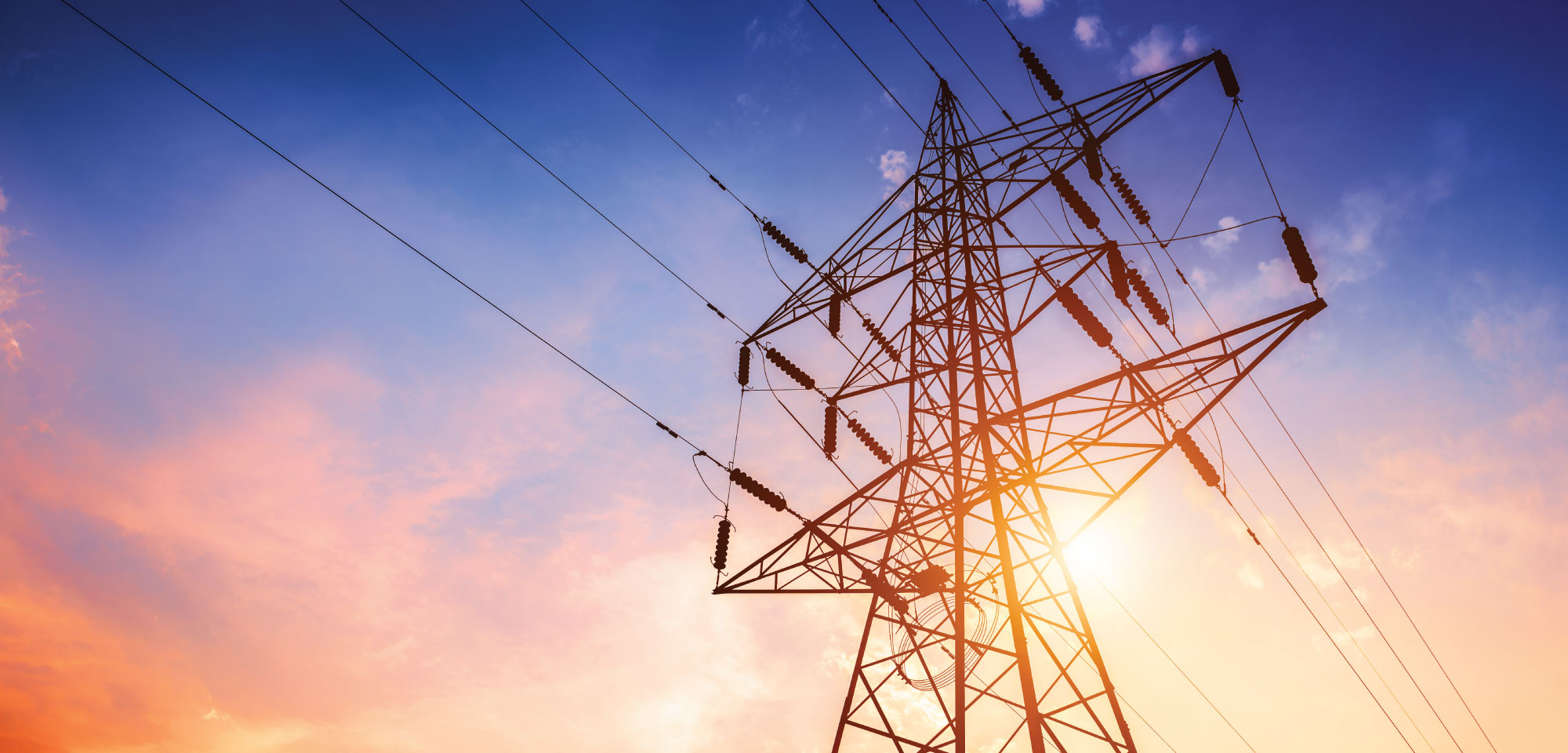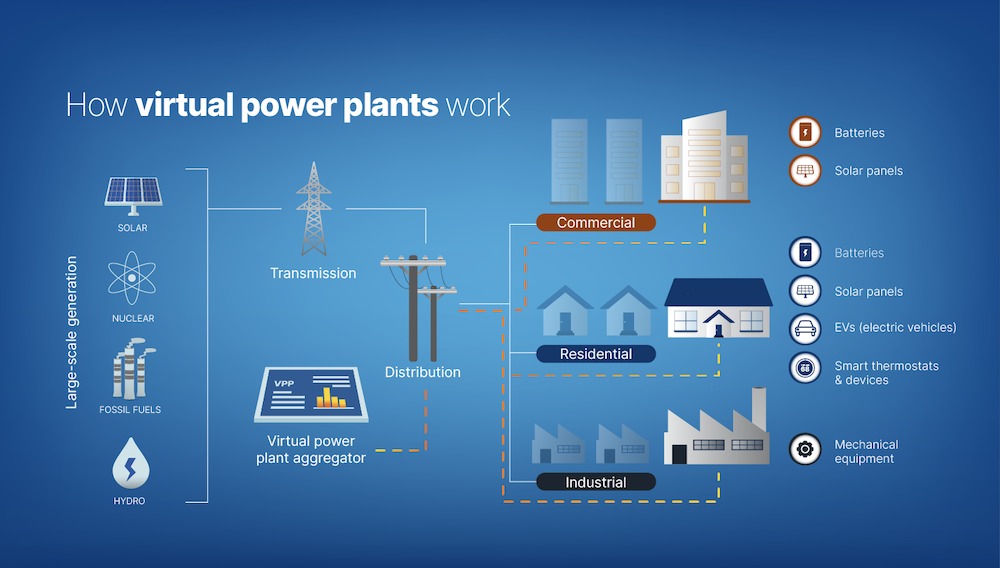Updated 1 year ago
Virtual power plants (VPPs): How they work and how homeowners can benefit
Written by
Ben Zientara

Find out what solar panels cost in your area
These days, it seems just about everything in your house can be connected to the internet in some way. From thermostats and water heaters to refrigerators and solar batteries, “smart” is the new black.
For consumers, these smart appliances provide convenience by allowing people to schedule energy usage, make remote adjustments, and receive alerts when things aren’t right. But for electric utility companies, these devices represent a revolutionary way to run the grid, respond to emergencies, and reduce costs for everyone.
In times of heavy demand on the grid, a utility company can use thousands of its customers' connected batteries and smart devices to respond to that demand by both drawing power from the batteries and reducing demand for power by selectively pausing smart devices. Essentially, these devices act like a virtual power plant to provide the grid with what it needs at just the right time.
Key takeaways
-
Virtual Power Plants (VPPs) are networks of devices that produce, consume, or store energy, which can be remotely operated to respond to increases in demand on the electrical grid.
-
The devices in a VPP are called assets, and their attributes are combined and used to support the grid by companies called aggregators.
-
VPPs provide power and demand response that replaces gas-fired “peaker” power plants, which are expensive and inefficient.
-
The benefits VPPs can provide to the grid are so great that utility companies often pay handsomely for the services they provide.
-
Homeowners with smart thermostats and/or rooftop solar and batteries can sign up with an aggregator to become part of a VPP, potentially earning up-front and ongoing incentive payments.
What is a virtual power plant?
A virtual power plant (VPP) is a network of small to medium power generating, consuming, and storage devices that are remotely operated to respond to increases in demand on the electrical grid.
The concept of VPPs has been around for over 20 years, first described as a theoretical concept by authors of a scientific paper published by the Institute of Electrical and Electronics Engineers (IEEE). Since then, the development of always-connected broadband internet has spread to cover nearly all populated areas in developed countries, and the concept of a VPP has morphed from an idea into actual physical and digital reality.
Aggregators and assets
The entity that remotely operates a VPP is called an aggregator because they control the combined power output capabilities and demand of many different grid-connected devices called assets. Each VPP has its own unique mix of assets, all connected to the electric grid in a specific geographic location.
The kinds of assets that make up a VPP can include:
Battery storage systems
Commercial and industrial equipment
EV chargers
Connected thermostats and HVAC systems
Other connected residential appliances
How VPPs help the grid
When the grid gets congested in the evening—especially on hot days when lots of people need air conditioning at the same time, utility companies need to find additional power. This last-minute power has traditionally come from a kind of power plant called a “peaker,” which burns a lot of natural gas very quickly to provide a big boost of power.
Unfortunately, there are several problems with peaker power plants. They’re inefficient and produce more emissions than other types of power plants. They are often located in low-income areas and are also much more expensive to run, sometimes costing utilities hundreds of times what it does to buy power at other times of the day.
VPP aggregators can do three major things to reduce the need for peaker plants:
Proactively activate devices like smart thermostats and water heaters before times of peak demand on the grid.
Selectively disable devices like smart thermostats, EV chargers, and industrial equipment temporarily during times of peak demand (this practice is called demand response).
Temporarily activate energy storage devices to respond to spikes in power demand.
Here’s an image that shows how these practices combine to respond to high demand on the grid and replace peaker plants:

An example
For example, here’s a thought experiment: Say there are 10,000 homes with air conditioners that run during a given day, and the air conditioners each draw an average of 3 kilowatts (kW) when they’re active. That means the maximum possible demand for running those air conditioners simultaneously is 30 megawatts (MW); 3 kW x 10,000 homes = 30,000 kW, or 30 MW.
That 30 MW of power wouldn’t always be needed, but grid operators would have to plan for that potential spike in demand.
Now, say each of those air conditioners really only needs to run for 20 minutes total during the hour to maintain a comfortable temperature. If all 10,000 homes were connected to a VPP, the aggregator could remotely operate the smart thermostats, allowing only one-third of them to ever run at the same time and reducing the maximum demand to run them to just 10 MW.
Essentially, limiting the maximum demand from 30 MW to 10 MW by intelligently controlling the home’s thermostats eliminates the need for a 20 MW gas peaker plant. That prevents the environmental damage caused by burning all that natural gas quickly and inefficiently and also saves the grid operator money on expensive energy purchases.
As we mentioned above, purchasing peak power can cost utilities hundreds of times what power costs at other times of the day, so the savings generated by VPP aggregators can be very substantial. That potential for savings means many utilities are willing to pay VPP participants for the service they provide to the grid.
How homeowners can take advantage of VPPs
Homeowners with smart thermostats and home batteries have an ever-increasing number of options when it comes to joining a VPP.
To participate, you generally need to sign a contract that states you’ll allow the VPP aggregator to either activate your battery or adjust your thermostat during peak evening times. Some VPPs require homeowners to participate on weekdays throughout the year, but others only activate the devices during days of very high usage due to extreme heat or cold.
That means giving up some energy storage or comfort for the good of the grid, but it can also be good for your wallet. VPP programs pay people for their participation, either through up-front or ongoing incentives.
Remember that VPPs are still in their infancy, so few places have fully-established programs. Additionally, many VPPs are closed to residential participation. Here’s a short list of some current VPP programs:
State(s) | VPP program | Details |
|---|---|---|
California | Part of PG&E’s Emergency Load Reduction Program, Tesla acts as an aggregator, and homeowners with Powerwall batteries in PG&E territory are eligible. Participants earn $2 per kWh served during an event, with a minimum of 20 hours of events per year. More details. | |
California | sonnenConnect | Currently open in California and spreading to other states “soon,” the sonnenConnect program offers owners of sonnen batteries the ability to earn ongoing rewards in exchange for allowing their batteries to be remotely managed. More details. |
California, Hawaii, New York | Swell Virtual Power Plants | Aggregator Swell Energy has several projects either in operation or planned in the three states listed. Participation requirements, incentives, and rules vary. More details. |
Connecticut, Massachusetts, Rhode Island | With thermostat and battery programs for customers of Cape Light Compact, Eversource, National Grid, and Rhode Island Energy in the three listed states, the ConnectedSolutions program offers up-front and/or ongoing payments to homeowners. More details. | |
Idaho, Utah | Owners of certain sonnen batteries whose systems are grid-connected and installed alongside a solar installation can apply to participate for a 4-year term, during which their batteries will be partially controlled by Rocky Mountain Power on an up-to daily basis. The utility offers up-front and ongoing incentive payments based on the number of kilowatts of power committed for service during program events. More details. |
Looking to the future
In the not-too-distant future, participation in a VPP will be seamless and virtually (pun maybe intended) invisible for people who own a home battery.
Batteries will charge during the day when solar panels produce more energy than people need and discharge in the evening when electricity demand is high. This will greatly reduce strain on the grid, saving everyone money on energy bills and making it possible for further electrification of homes and cars.
Speaking of cars, they will likely become a major source of energy storage for virtual power plants as vehicle-to-grid technology becomes more widespread. The average home battery can currently hold around 15 kWh of energy, while the average car battery holds more than 4 times that amount. Electric cars and buses plugged into the grid will become an essential part of our connected world.
Ben Zientara is a writer, researcher, and solar policy analyst who has written about the residential solar industry, the electric grid, and state utility policy since 2013. His early work included leading the team that produced the annual State Solar Power Rankings Report for the Solar Power Rocks website from 2015 to 2020. The rankings were utilized and referenced by a diverse mix of policymakers, advocacy groups, and media including The Center...
Learn more about Ben Zientara